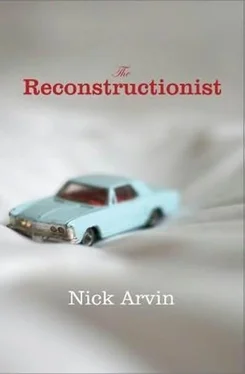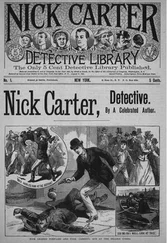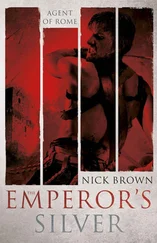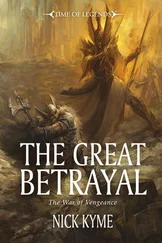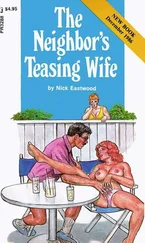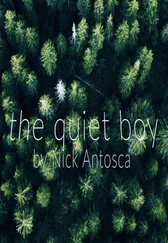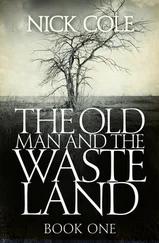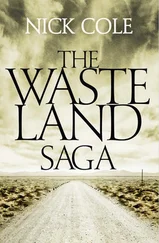With a little clawing motion she burst into talking about a couple more people. He felt like a disappointment. Soon she looked over to the pet store – Kissing Kritters – as if it had just now appeared, cast out a farewell and fled.
He was glad to drive again. The land streamed by and he worked out a sense that some of the people she had mentioned had been a grade or two below himself, and if she were also from one of the lower grades that might explain how she had been so aware of him while he could not recall her at all. Or perhaps Christopher’s death had made everyone aware of him. Nonetheless, he had a feeling of precarious nullity: the place where his brother had died was no longer the place where his brother had died, and Kari Butters indicated a world that had once been his life and yet now he hardly recognised it.
When he reached the house and found Heather there, he embraced her with an urgency that he saw startled her.
That night he lay naked beside her, and he recalled that she had never answered his questions about Christopher’s accident, but he also hated to be holding any secret from her. Having begun this examination of Christopher’s accident he felt himself in the midst of a betrayal that he could hardly afford when without her he might dissipate, a phantom of smoke, an odour of tyre rubber.
On the interstate the next day he passed signs and exits, fields and woods that should have been perfectly familiar from the day before and yet much of it appeared strange and newborn. Then, in Coil he had to stop and think for several minutes to recall where to find the police station.
Like the high school, like the library, the police station had not changed: an almost windowless beige brick building, its function named across the front in aluminum letters. He had entered it only once before, years ago, on a grade school field trip led by a teacher named Mrs Hose – with a hair out her nose , went the playground chant. The children were fingerprinted onto souvenir cards, and they peered into a holding cell. He had been disappointed that it had no steel bars, only pink walls. Pink, said their guide, a woman who normally sat at the reception desk, was soothing.
He wasn’t sure that it wasn’t the same woman, now much older, who sat at a desk by the door and nodded and darted glances at him while he explained his purpose. The accident report that he wanted was very old, she said, and it wouldn’t be here but at a document-holding facility maintained by the county. She drew a map on the backside of an ‘Emergency Preparedness’ brochure, lining roads and highways atop a bulleted list of first-aid items.
Her route took him through the intersection where Christopher had died and onward between two silvered lakes under a vast cream sky, through cow fields, and along the edge of a regional airport where prop airplanes came down and went up with dragonfly noises, to a warehouse with a bank of offices stretched along the front. Its gutters sagged and the appliqué window tints had bubbled. A receptionist sent him to a heavy, balding, moustached, cubicled man in beige pants and a mauve shirt who listened to what Ellis wanted, spent a few minutes peering into an old, DOS-based program on his computer, wrote down a number, said, ‘Please wait here,’ and went away.
Ellis studied a photograph on the desk – two fat children grinned before a pull-down backdrop of washed-out blue – until he wanted to smash it. The man returned with a manila folder. He said that he could xerox the text of the report for ten cents a page, but the photos would have to be sent to the photo lab for prints, which would take several days.
He went away to copy the report, and Ellis sat with the stack of photos – color glossy 4x6s. Minutes passed while he sat not looking at the photos, thinking only of putting them aside, standing and leaving.
Then without any conscious prompting his attention settled onto them. The first photo, mostly black, showed a view straight down at an asphalt road surface with someone’s black shoe – probably the photographer’s – gleaming in the corner, and he could not tell if the photo was taken in error or if it was supposed to show something on the road that could not be seen, a tyre mark, perhaps. The second photo offered only more black and a double yellow lane line crossing it diagonally. In the third photo shapes could be made out – a lamp post, a portion of a parked police cruiser, and in the middle distance a burned vehicle bellied on the street, an overhead light reflecting weakly from the patches of unburned paint on its front end. Between the burned car and the camera lay a blanket-covered shape that was, almost certainly, Christopher, and Ellis experienced a surge of feeling that he had not prepared for. A ferocious hot pain. He set the photos aside. He had not taken them up again when the fat man returned with his copy of the report. Ellis gave him a cheque and asked to have the photos mailed to his apartment’s address.
He had not been to his apartment since the day after the accident with James Dell. The silent grandfather clock, the shelves of books – everything here held a layer of dust, which obscurely pleased him, and he tried to disturb it as little as possible. He sorted the mail heaped under the mail slot – junk mail, magazines, catalogues, bills, overdue notices – and when he found the photos he opened the envelope quickly, to pre-empt hesitation, and turned through the images. The pain that had caught him the first time he had looked at them did not resume. Christopher’s body was visible in just three photos and was never the centre of focus, only a thing under a blanket in the middle distance. Ellis looked at it calmly. Why? He didn’t know. Was this how he should have felt when he first saw the photo? Or had the feeling before been the true feeling?
The evidence in the photos seemed generally as he had expected – short tyre marks left by the airlane , a point of impact indicated by a spill of fluid and glass in the middle of the intersection, two cars standing at their points of rest, police and fire vehicles scattered around the periphery, everything muddled by the surrounding murk of night. Strange to see how long ago it all appeared – the boxy cars, the men with shaggy hair and moustaches, a sign in the background offering a gallon of gasoline for less than a dollar. It had been an Amoco station – so, he and Heather had both been wrong. He went back and forth through the photos, thinking, If you look long enough you will see something new. He didn’t; but when he finally set the photos down, the objects of his apartment appeared strange, as if their dirt and wear had been caused by someone else.
Working between the photos, the police report and the measurements he’d made at the intersection, he built a diagram of the scene in his computer. He drew dimensionally correct icons to represent the cars at their points of rest, then he studied the damage on each vehicle and the tyre marks on the roadway to estimate their orientations as they collided and set the icons at the point of impact and at maximum intrusion with a couple of inches added to account for restitution – his brother’s airlane striking the left rear-quarter panel area of the other vehicle at a little less than ninety degrees, the result of both vehicles swerving too late.
When he finished, the diagram showed an overhead view of the lane lines, the kerbs, the poles at the corners, the two cars at the instant of impact and the positions where they had come to rest. This was, in a sense, the place where Christopher had died.
He copied the scene diagram into a specialised accident reconstruction program called PC-Crash – when he started working with Boggs he had thought a lot of jokes would come of the name, but it had only become part of the background: chair, calculator, email, PC-Crash . Within the program he created representations of the two cars that included suspension characteristics and passenger weights – he tried for a minute to remember what Christopher’s weight might have been, but finally settled for using a published statistical average. He set the simulated vehicles onto the icons at the point of impact, adjusted their velocities, steering angles, brake factors and restitution. Then he ran the analysis and watched as they spun away from the impact toward the rest positions. The airlane overshot its mark by a dozen feet, while the other vehicle didn’t go far enough and ended up facing the wrong way. He began to make adjustments. Velocity. Steering angles. Brake factors. Restitution factors. Small changes sometimes resulted in large effects in post-impact motion, but after a couple of hours he had refined the model so that the vehicles spun away from the point of impact, scrubbed speed off as they went round and rocked to a stop exactly on the icons where he had marked the rest positions.
Читать дальше
